
|   |

|   |
6th edition of Delhi International Arts Festival 2012 - Dr. Sunil Kothari e-mail: sunilkothari1933@gmail.com Photos: Avinash Pasricha November 18, 2012 Once again, Delhi International Arts Festival (27th Oct - 10th Nov 2012) took Delhi by storm in its 6th edition with a grand gala opening at Purana Quila on 27th October when under the title of Shared Culture-The Sufi lineage, the Qawwal from India, Pakistan, Afghanistan, Bangladesh, Uzbekistan performed together and the Whirling Dervish dancers from Turkey with their whirlings created magic. The old ramparts of the Purana Quila reverberated with the Qawwals' lusty voices creating an amazing atmosphere. Never –say-die Bharatanatyam exponent Prathibha Prahlad has been at it for the past five years with dreams to sensitize the Delhiites with a large scale, multi-venue, multi-arts festival in winter season, ushering it with songs, dance, music, drama, puppet shows, classical dance performances, a film festival, book launches, exhibitions of paintings, jazz, and what have you! The events at various venues bring hordes of crowds and the city celebrates in an amazing manner, feasting eyes and ears to an array of mindboggling variety of performing and plastic arts. Prasiddha Foundation in collaboration with Indian Council for Cultural Relations has mounted this most ambitious festival, winning appreciation of thousands of Delhiites, who are exposed to international fare of arts of diverse nature. More than 30 countries are participating and from all over India, musicians, dancers, theatre people, painters, authors, film makers, cine buffs, aficionados of Western music converge in Delhi. Parallel performances are held at various venues and often one finds it difficult as what to select and what to forego. Being a dance buff, I maximize dance fare of national and international variety. The Prasiddha Dance Repertory from Bangalore 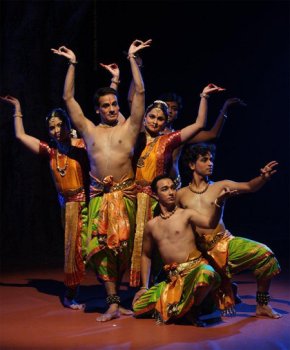 Another deity invoked was Lord Shiva. With Nagendra haraya,Triloachanaya, Bhasmaya ragaya Digambaraya, shlokas, one by one the description of Lord Shiva, his attributes, Ganga flowing from his matted locks, Shiva as Pramathanatha, Nandikeshwara and suggestive episodes like destruction of yagna of Daksha, when Parvati was insulted, was captivating. Interspersed with pure dance, the group choreography embellished the presentation. In another composition, Vishnu's epithets were captured. Sheshashayi, sleeping on a serpent, Garuda vahana, astride the Garuda bird, were imaginatively presented. The dancers standing behind with arms forming hood of serpent, spreading feathers when peacock dances, entering with arms in a diagonal position, utplvavanas, light jumps, alignment of bodies, uncluttered entries and exits, gave an impression of well rehearsed dance numbers with flawless movements. Interweaving in Sri Krishna Sharanam Mama in raga Hindolam, Dasavatara (ten incarnations) and in finale admonishing Arjuna when he does not want to fight in Kurukshetra battle, Krishna as his charioteer, taking Vishwarupa, were imaginatively choreographed sequences. All the Bangalore based dancers both female and male acquitted themselves well. Satyanarayana Raju stood out for his excellent dancing and choreography. Bharatanatyam as it has its own standing in Bangalore was well showcased. Flamenco and Kathakali The next presentation of The Killing of Dussasana as a joint collaborative work of Flamenco and Kathakali aroused great curiosity. Presented by Institute Servantes, Spain Embassy, produced by Eva Gonzales, and directed by Cesar Lorente, it was an interesting cross cultural attempt. The female Flamenco dancer Tamar Gonzales in role of Draupadi, dressed in her traditional black Flamenco costume with a red shawl, danced with vigour. Her taut body and exquisite arms and wrist movements to the typical Flamenco music, with guitar played by a male musician Julian Vanquero, were impressive. The artists from Kerala Kalamandalam, with Dussasana in red beard make up, bulging skirts, big crown, larger than life look, and Raudra Bhima with small mace in his hand, did their job well. As is the practice in Kerala in an open air Kathakali performance, the character of Dussasana appeared from the audience and moved freely in the auditorium creating excitement. He dragged the Spanish Flamenco dancer by her hair, and struck fear, she with aggressive look dismissed his advances, Dussashana disrobed her and she ran away. Raudra Bhima appeared, consoled her, promised her to anoint her hair with Dussashana's blood and challenged Dussasana to fight with him. The fight sequences were held in the auditorium, Bhima chasing Dussasana, and fighting on stage. Finally, Bhima takes out Dussashana's entrails and opens his stomach, drinks his blood and anoints Draupadi's hair with blood. The entire presentation was gripping and the audience loved it. The fight scenes could have been abbreviated. Kathakali actors Kalamandalam Biju Kumar and Kalamandalam Bujulal Narayan Pillai from Kerala seemed to compromise a little while performing with Flamenco dancer and musician. The Kathakali musicians played in synch with Flamenco guitarist, giving an overall harmony. The Flamenco dancer was in her element in the role of Draupadi and in spite of the cultural differences, the way she with her body taut like bow, through as it were angikabhinaya, entire body speaking won over the appreciation of audience. At the end the audience gave them a standing ovation. It was indeed a fusion which did succeed. Ratan Thiyam's Chorus Repertory Theatre, Imphal: Tagore's King of the Dark Chamber On29th October at Kamani Auditorium, the renowned theatre director Ratan Thiyam presented Tagore's play The King of the Dark Chamber. This symbolic play received an excellent treatment from Ratan Thiyam. As usual it was visually stunning and was enacted with the customary finesse by his actors. The presence of the king is suggested by the black cloth as a back drop. The queen Sudeshana wishes to see the king who suggests to her to have an inward journey to find herself. In the final sequence, the black cloth larger than life turns into an image of a king who embraces the queen. Even when the play was in Meitei language, the visuals were captivating and as it were spoke volumes to appreciate the symbolism. The music, barring one strain of Tagore's song had typical Manipuri music, which added charm to the performance. Imaginative, original and with a large cast of 30 actors, musicians, Chorus Repertory's plays have received universal appreciation. To strike a personal note, I have travelled with the company and Ratan Thiyam abroad and have seen the audience response which has been always overwhelming. Like a painter, with exquisite lights design, Ratan paints on a vast canvass, scene after scene. It was one of the highlights of the DIAF 2012. Scottish Dance Theatre from UK 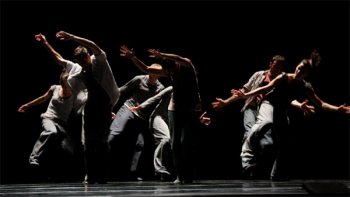 Of the three choreographic works the first was 'Drift' (11 minutes) by James Wilton featuring two dancers Matthew Robinson and Natali Trewinnard, to the music by The Package, by A Perfect Circle, Eraser by Nine Inch Nails and lighting by Emma Jones. As the program note mentioned it indeed seemed to push the dancers to their physical limits. The powerful duet explored loneliness and closeness, absolute commitment and high risk trust. The dancers came together, separated, showed indifference, threw each other on the floor, moved in circle and ended with holding hands, completely exhausted. The young dancers performed with great stamina and one could see how through their movements they expressed all this powerfully. Next work 'Dog' choreographed by Hofesh Shechter (31 minutes) was an exhilarating piece. It bounded between riotous celebrations and uncertain calm. The choreographer Hofesh Shechter is recognized as one of UK's most exciting contemporary artiste with his company touring worldwide to critical acclaim. The contemporary dance as seen in his work was befitting his reputation. Dancers performed with youthful zeal to music sourced form various musicians and excerpts from Braziliero by Sergio Mandes, Verdi, Bacj and Sleph. Lighting was by Bruno Poet and costumes by Phyllis Byrne. I could not see the last piece 'Luxuria' choreographed by Liv Lorent which the programme notes described as a majestic work that is both witty and tender, exploring desire and our search for fulfillment. Visually arresting, cinematic and with a haunting classical sound track, Luxuria was considered a feast for the sense. I missed it. My loss. The packed audience responded well to the visiting company and one would congratulate DIAF for including such international fare. With other dance festivals taking place simultaneously I missed the superb Flamenco by Eva Yerebeuna from Spain at Siri Fort on 3rd November and subsequent performances and diverse fare. But I caught up with the dance segments from 6th. Talking to God in the Mother tongue To celebrate the lives and poetic compositions of women bhaktas and sufis through dance and music, Madhu Kishwar and her Manushi Foundation joined hands with DIAF and with support from Ministry of Culture, ICCR, The Neemrana Music Foundation, Government of NCT, Delhi presented a series of dance and music performances with the theme of women poets' devotional outpourings with a galaxy of established dancers including Rani Khanam (Kathak), Lakshmi Vishwanathan (Bharatanatyam), Jhelum Paranjape (Odissi), Vanashree Ramarao (Kuchipudi), Kiran Segal (Odissi), Dr. Sandhya Purecha and her troupe (Bharatanatyam), Revathi Ramachandran (Bharatanatyam) and Saswati Sen (Kathak). On 6th November at ICCR's Azad Bhavan Auditorium, Madhu Kishwar introduced the theme of women devotees form various walks of life and gave an excellent introduction to bhakti movement and how some women left their married life and social bonds, some like Lal Ded in Kashmir moved alone and naked, Meerabai left royal palace and joined the group of sadhus, so did Akka Mahadevi in Karnataka. The sufis and saints, the abhangas of Janabai in Maharashtra resonate with intense devotion. Karaikkal Ammayar, Andal from Tamilnadu, Muddupalani from Andhra Pradesh are women devotees who sang songs on love for God. Madhu Kishwar said that the documentation of these women poets is an ongoing process and the initiative continues. Parvathy Baul is known for her solo rendering of the oldest style of Baul music and dance. With her child like innocent personality, she sang intensely and danced beautifully. She has inherited this style form the parampara of Sanatan Das Baul from Bankura District, who followed the style of Nitai Khapa. She sang songs of Baul gurus of Bengal, Radha Adishakti, Jadubindu and others and offered the audience a spiritual experience. 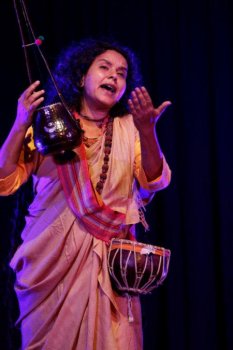 Parvathy Baul 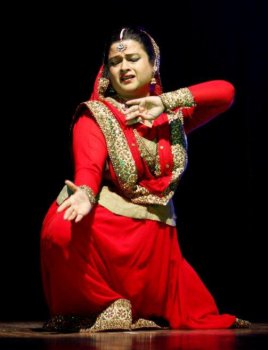 Rani Khanam Rani Khanam, the seasoned Kathak exponent is well known for her Sufi songs danced in Kathak style. She is the sole dancer who has set Islamic verses and Sufiana kalam. She chose vakhs of Lal Ded of Kashmir and one song of Meerabai. The vakhs describe body as a boat to cross the ocean of life, she pleads to the Lord to make her a perfect earthen pot, to steer safely, like Krishna as a charioteer in Kurukshetra war. In Meera's song Banke Bihari, using pure dance of Kathak interspersing it with pirouettes, tatakar and gats for showing alternately Krishna and Radha, she showed the back of the palm as dark for Krishna and front of the palm as fair Radha. The union of the two was movingly portrayed. The image of Girdhari Krishna with peacock feather was portrayed beautifully with intense feeling. From Chennai, veteran dancer Lakshmi Vishwanathan, known for her abhinaya, displayed through dance what a consummate artiste she is with compositions of Karaikkal Ammayar. One of the 63 Shaivite saints, she is the only female saint and seeks the vision of Lord Shiva, renouncing her marriage and begging the Lord to turn her into an emaciated and ugly being, so that she can only look at him and avoid worldly people's gaze. She wants to remain in cremation grounds so that she can watch the Lord. She had vision of the Lord and at Tiruvalangadu she saw Shiva's Urdhva Tandava when he defeated Parvati in a dance duet with him. She is often seen represented in sculptures as an old skeletal hag at the feet of Lord Shiva. To the various sounds of dundubhi, talam, damaru, she watches Shiva's dance in amazement and devotion. Taking the song Andal sings to koel bird, she urges her to go and bring her Lord who holds in his hands chakra, conch, mace and lotus, who is adorned with vanamala, garlands of flowers, who is Sriman Narayana, who as Rama killed Ravana. Known as Kuyil paattu, song to Koel, Andal pours her heart, telling her that 'you may fly high, but my Lord scales the three worlds.' Then she describes the natural beauty of Srivilliputtur, her birth place, from where even today the garlands are brought to Tirupati. She describes its beauty where swans swim in the ponds and birds chirp joyously. Instead of taking Tiruppavai songs, Lakshmi selected Nachiyar Tirumozhi and invested her dance with alluring movements. Muddupalani poet's 'Radhasantavanamu' is best known for her daring to describe the shringara boldy next to Jayadeva's Gita Govinda. Krishna seeks Radha and dismisses Madana, throwing his flowery arrows, moon showering cool rays, cuckoo bird hums sweets tunes, the fragrant breeze from direction of the mountain - nothing interests Krishna except the presence of Radha and compared to her, all these characters pale into insignificance. With a look of contempt, Lakshmi expressed Krishna's emotions in a telling manner as only she can. Her abhinaya has an old world charm, now rarely seen. Muddupalani was a rebel. Bravo, Lakshmi, for such an engaging selection. 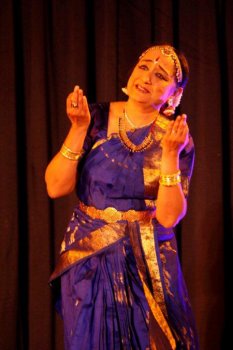 Lakshmi Vishwanathan 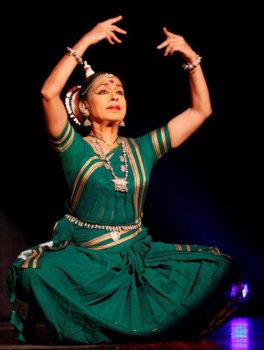 Jhelum Paranjape Jhelum Paranjape, modifying her Odissi costumes slightly with Maharashtrian touch, using Odissi technique in Mangalacharan prayed to Vithoba. In Janabai's abhanga, she depicted Vithoba's love for her, the Lord wanting to help her in her daily chores, like when she goes to fetch water, he helps her; when she is grinding, he moves the stone wheel; when she is pounding rice, he helps her to pound and so on. Very charming and evoked Maharashtrian flavor. In another abhanga, she depicted suggestively how the Lord helps his devotees, how when the Gajaraja (elephant king) was caught by a crocodile, the Lord sent Sudarshan chakra and saved his life; when Dussashana attempted to disrobe Draupadi in full view of the kings and Pandavas in a court after Yudhishthir lost in game of dice; how Krishna subjugated Kaliya –all episodes were enacted with artistry. The audience responded when she enacted the game of dice and Dussashana was shown fainting after pulling endless saris! Jhelum was supported by a team of musicians who lifted the performance to a greater height. On 7th November, Arati Ankalikar Tikekar rendered Meerabai's bhajans, Janabai's abhang and Akka Mahadevi's Kannada vachan in her melodious voice. Trained by a galaxy of gurus, including Kishori Amonkar, Arati sang soulfully. Manpreet Akhtar in her robust voice rendered Sufi songs of Punjab's poetess Dheero Preman, in Punjabi with a full orchestra. Kuchipudi exponent Vanashree Rama Rao presented Lal Ded's Kashmiri poem in praise of Lord Shiva. She included the shloka Angikam Bhuvanam Yasya and also Mritunjaya mantra, when Yamaraja comes to take away Markandeya who is worshipping Lord Shiva and offering puja to Shiva linga. He clings to Shiva linga and Lord Shiva appears and saves him from the noose of Yamaraja. It was performed with devotional feelings and was in tune with Lal Ded's spirit. One has often seen Vanashree perform with her husband Guru Jaya Rama Rao in duet. Therefore it was very interesting to see Vanashree in her solo exposition. In a padam by Kshetrayya, in Mohana raga and misra chapu tala, the nayika asks her friend, who is he? Who looks at me all the time from the garden? Vanshree had studied this padam from late Nataraja Ramakrishna. With minimal abhinaya, internalized feelings of bashful nayika, using nayanabhinaya, (expressions through the eyes), Vanashree projected the abhinaya of old world charm, and typical of Nataraja Ramakrishna's style. The nayika tells her sakhi that 'he says he is Kamadeva and makes advances and embraces me, which is like a great bliss. He has gone to forest and I see his footprints which I shall worship by placing Parijata flowers because he is none else than Krishna and is the Lord.' The graceful ways in which Vanashree expressed these feelings left an indelible impression. She concluded with a Meera bhajan in Desh raga. The mood of bhakti and surrender permeated her entire frame. Sudha Raghunathan's vocal support, Raghunathan's flute, and other musical support on mridangam, tabla and sarangi and lighting were complimentary, highlighting Vanashree's presentation. 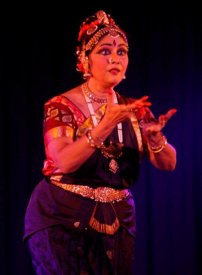 Vanashree Rama Rao 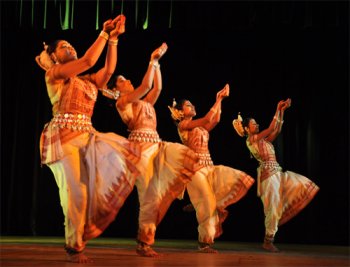 Ileana Citaristi's group On 8th November at Sri Ram Centre, Italian dancer Ileana Citaristi premiered her new choreographic work 'Kaal-Time bound' in Odissi as a group work with dancers from Bhubaneswar. An abstract theme, concept of time, its visualization in terms of different stages of evolution, through geometrical patterns, straight lines, triangles, squares, circles, helix and as straight as an arrow piercing past, present and future, myth, eternally returning to some point, creation, Kaalachakra, timelessness and NOW. The concept and choreography were by Ileana Citaristi, music by Annada Prasanna Patnaik, the libretto by Devadutt Chhotray. It opened with a young group of dancers moving with an extended arm, like hand of a clock, to solfa notes and they created various patterns. They moved diagonally, with back to the audience, crossed each other and danced rhythmically. Followed the text in Sanskrit about Kaal, elements of water, rising sun, emergence of Prithvi and was interspersed with Odiya poetry describing space, sky, tangible and intangible objects, moon, stars, waves and throbbing life, when Ileana entered for that section Spandan. The dancers evoked time imaginatively in terms of geometrical lines taking chauka bhramari, three dancing in terms of triangle shooting as an arrow, with dancers shooting arrow one by one, standing, sitting, turning around with interesting choreography, using the mnemonics of Odissi. The progression of element of time was thus performed in an abstract manner. I could not see the complete work, as I had to catch up with other performances at Azad Bhavan of dancers Kiran Segal (Odissi) and Dr. Sandhya Purecha (Bharatanatyam) from Mumbai. Before Kiran and her troupe's presentation earlier Meeta Pandit had presented compositions in Hindustani music, followed by Bombay Jayashri. I could catch up with three compositions by her. After presenting a song of Andal, she took one of Ambujam Krishna in Revathi raga about Krishna's promising that he will come back, but had gone away and the devotee did not know when he will return. The pathos was well conveyed by Bombay Jayashri in her mellifluous voice. She rendered movingly Akka Mahadevi's vachan in which she asked Malllikarjuna Shiva: 'If I am hungry I can get bhiksha, in trouble beget solace and in the ruins of the temple I lay my head, O Lord I see you there to support me.' The feeling of surrender was deeply felt. She sang the Kannada vachan with intense feeling of devotion, which lingers for long in memory. She is a vastly gifted Carnatic vocalist. Kiran Segal chose compositions of Kuntala Kumari Sabat, known as Utkal Bharati. She was from Bastar area, was educated in Burma, turned Christian and married Krishna Prasad, an Arya Samajist, and settled in Odisha. Her poems speak of religious fervor. Of the three poems, in the first one she asks the Lord, where does he stay, in the sky, ocean? He reassures his devotee that she need not look for him anywhere. Just look into her heart and she will find him. Kiran presented her three disciples who enacted questions and performed nritta sequences. Kiran moved from one end of the stage to another seeking the Lord. The song was in Gauda raga and performed to triputa tala. The second song was about Hari Hara and dwelt upon rituals, incorporating ten incarnations, suggesting that the Lord in various manifestations is one, be it Krishna or Christ. Kiran crossed her heart indicating image of Christ. Set to Ananda Bhairavi raga it was choreographed to describe his many forms and for a devotee, the Lord was one whatever form he took. The dancers wore white dhoti like lower garment over Odissi costumes, and it did not look pleasant. Kiran would do well to avoid that costume as visually it jarred. The final composition was a prayer on Shakti. The devotee begs of the Goddess to give her strength, enlightenment, and bless her else her life is incomplete. Set to Bhairavi and talamalika, the number saw Kiran worshipping Shakti, taking stance of the Goddess and other dancers offering prayer. The musicians included Saroj Mohanty (vocal), Prashanta Maharana (percussion), Shashi Shekhar (khol) Gopinath (violin) and lighting was by Sandip Dutta. 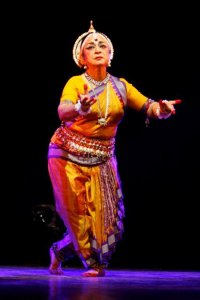 Kiran Segal  Shanti Mohanty & Dr. Sandhya Purecha Dr. Sandhya Purecha with her well trained disciples in Bharatanatyam, presented abhanga of Janabai in a dance-drama form, with Vithoba, played by an attractive disciple of hers with a commanding stage presence and other dancers creating imaginative choreography and dramatic sequences. Lord Vithoba was like Janabai's friend and helped her in her daily chores, fetching water, pounding rice, even developed boils on his palms as he held the rod to pound rice; when Janabai was thirsty, he brought water for her; she swept the floor and Vithoba took the garbage on his head; walked with her carrying pots of water. Sandhya as Janabai and Shanti Mohanty as Vithoba performed with excellent rapport winning audience appreciation. The entries, exists, groupings and movements were impressive. The dancers took leaps like deer, walked gracefully like swans, flew like birds. Other event dramatized was of Vithoba spending a night at Janabai's house. Before dawn Janabai wakes up Vithoba to return to the temple. In hurry, the pendant of the necklace of Vithoba slips in Janabai's house. The Brahmin priests see Janabai stealthily returning from the temple and later on find that the pendant was missing, which they accuse Janabai of stealing. When it is found in her house, they punish her and plan to hang her. Janabai begs of Vithoba to come and help her, but he does not seem to listen. Therefore she screams aloud that Vithoba is dead, when the river Chandrabhaga in which after hanging her, priests were to throw her body, overflows and sweeps away the people who were to punish her. Thus Vithoba saves Janabai. It was enacted with intensity and suspense as to when Vithoba would help Janabai. Sandhya also brought a composition of lesser known women saint like Soyarabai. To test her devotion, the Lord takes the form of a Brahmin and asks for alms. Soyarabai, whose husband is always worshipping god Chokhamela, tells the Brahmin she does not have anything, not even a child. The Lord tells her to give some rice with milk which she gives and a little is left, which the Lord tells her to eat, whereby Soyarabai begets a child and she worships him for the rest of her life. Very touching tale. Finally Sandhya presented Venabai's episode. She was a disciple of Ramadas Swami and only woman saint who has written Sita Swayamvara and other Rama related stories and songs. She dealt with Ramachandra giving abhayadan, Kaula, meaning promise to fulfill whatever his devotees asked for. Everyone asks for material wealth and comforts of life. Venabai asks Lord Rama to give peace of mind so she can devote herself to worship him. Shanti Mohanty as Lord Rama looked majestic and the rest of the dancers and Sandhya played the various roles competently. In all departments, technique and choreography, execution of movements, aharya, costumes, singing abhanga, music and overall presentation, the production was outstanding. Madhu Kishwar assured Sandhya that she would be invited once again to Delhi to present her work in one full evening in future. Sandhya and her dancers received critical and enthusiastic appreciation from the cognoscenti and layman alike. Sandhya deserves to be seen more often in the Capital. 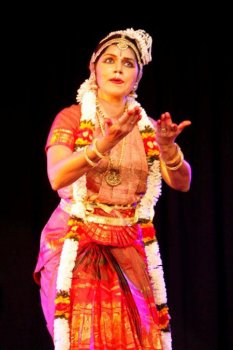 Revathi Ramachandran 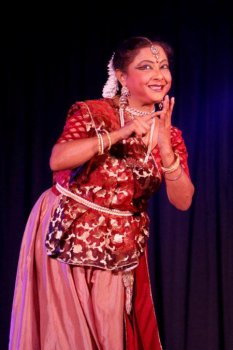 Saswati Sen I could not attend Revathi Ramachandran's and Saswati Sen's performances on account of conflicting events, as I was attending SNA Awardee senior dancer Geetanjali Lal's Kathak recital at Muktadhara Auditorium next to Natya Ballet Centre from where to rush to Azad Bhavan with mad pre-Diwali traffic was impossible. I am sure Revathi who is a brilliant senior Bharatanatyam exponent from Chennai would be invited again to perform. Saswati Sen is Delhi based and her fame and name have spread all over the nation and abroad. These stalwarts have rendered great service through dance dedicating their lives. It was a welcome concept on part of Madhu Kishwar to focus on women saint poets and it was successful. In future, instead of four artists per evening, three would be better so that artistes get an opportunity to do justice to their selection. Delhi International Arts Festival 2012 was a resounding success. It has raised the bar of artistic fare and brought international companies which had full houses. Through hard work, an artiste in her own right, Prathibha Prahlad has within a span of six years proved that a determined individual with a vision can do wonders. I am confident whatever teething troubles Prathibha had to face would be overcome next year with advance planning taking into account whatever lacuna were found this time. Prathibha has put Delhiites under a debt of gratitude. Bravo, Prathibha for your grit, determination, focus and admirable ability to mount such a huge multi-arts, multi-venue, mind-boggling festival!  Dr. Sunil Kothari is a dance historian, scholar, author and a renowned dance critic. He is Vice President of World Dance Alliance Asia Pacific India chapter, based in New Delhi. He is honored by the President of India with Padma Shri, Sangeet Natak Akademi award and Senior Critic Award from Dance Critics Association, NYC. He is a regular contributor to www.narthaki.com, the roving critic for monthly magazine Sruti and is a contributing editor of Nartanam for the past 11 years. Post your comments Pl provide your name and email id along with your comment. All appropriate comments posted with name and email id in the blog will also be featured in the site. |